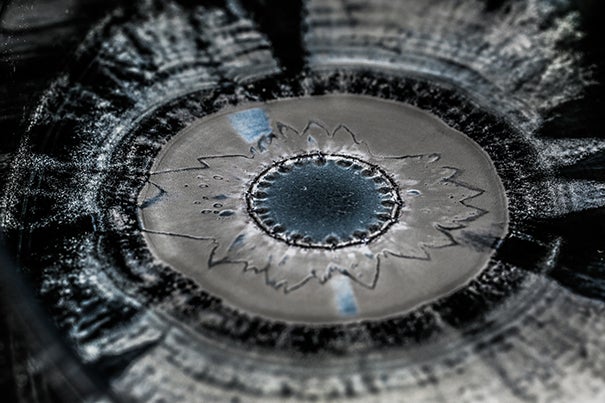 |
| A matter of size |
Also, in the previous post of this series I pointed out that:
"... today we take a look at the unique lists of DNA/RNA codons found in Toxoplasma gondii ("toxo") and Homo sapiens ("human") genomes from a different perspective.
What is shown is that the unique codons of toxo and humans are identical.
They are presented in today's Codons R Us appendix for your perusal."
(Quantum Biology - 15). Can a million atoms "think", even if less than a hundred can't "think", is where this post is going, because of the many hypotheses which boil down to "everything is in fact a matter of size".
Now, I have done the same thing with Coronaviridae database rows so as to compare their RNA codons to the Toxoplasma gondii mRNA codons.
Here are the results:
"After 13,788 coronaviridae and 4,766 toxoplasma gondii
database rows, the codons and amino acids match.
Toxoplasma gondii codons:
GCU,UGU,UGC,GAU,UUU,UUC,GGU,CAU,AUU,AUC,AUA,CUU,CUC,
CUA,CUG,UUA,UUG,AUG,AAU,CCU,CGU,UCU,UCC,UCA,UCG,AGU,
ACU,GUU,GUC,GUA,GUG,UGG,UAU,UAC,UAA,UAG,UGA
Coronaviridae codons:
GCU,UGU,UGC,GAU,UUU,UUC,GGU,CAU,AUU,AUC,AUA,CUU,CUC,
CUA,CUG,UUA,UUG,AUG,AAU,CCU,CGU,UCU,UCC,UCA,UCG,AGU,
ACU,GUU,GUC,GUA,GUG,UGG,UAU,UAC,UAA,UAG,UGA
Toxoplasma gondii amino acids:
ACDFGHILMNPRSTVWY
Coronaviridae amino acids:
ACDFGHILMNPRSTVWY"
The coronaviridae types in my SQL database were "alpha", "beta", "delta", "gamma", "mers", and "sars" types, as follows:
mysql> select count(*) from corona;
+----------+
| count(*) |
+----------+
| 13788 |
+----------+
1 row in set (0.02 sec)
mysql> select count(*) from corona where type = 'alpha';
+----------+
| count(*) |
+----------+
| 1278 |
+----------+
1 row in set (0.00 sec)
mysql> select count(*) from corona where type = 'beta';
+----------+
| count(*) |
+----------+
| 100 |
+----------+
1 row in set (0.00 sec)
mysql> select count(*) from corona where type = 'delta';
+----------+
| count(*) |
+----------+
| 203 |
+----------+
1 row in set (0.01 sec)
mysql> select count(*) from corona where type = 'gamma';
+----------+
| count(*) |
+----------+
| 514 |
+----------+
1 row in set (0.01 sec)
mysql> select count(*) from corona where type = 'mers';
+----------+
| count(*) |
+----------+
| 611 |
+----------+
1 row in set (0.01 sec)
mysql> select count(*) from corona where type = 'sars';
+----------+
| count(*) |
+----------+
| 11082 |
+----------+
1 row in set (0.01 sec)
What this shows, again as in the previous post, is that the unique codon components of any corona virus, toxoplasma gondii, and homo sapiens genomes is fundamentally the same.
Any difference is in quantity of codons, not type of codons.
The same goes for the atoms that make up the codons in those genomes (see e.g. Appendix QB.7.1, Appendix QB.7.2, Appendix QB.7.3, Appendix QB.7.4, Appendix QB.7.5, Appendix QB.7.6, Appendix QB.7.7, Appendix QB.7.8, in Quantum Biology - 7).
Thus, the same can be said again:
"This is where we focus on the art shown in Fig. 1, Fig. 2, Fig. 3, and Fig. 4, because what holds humans and toxo together comes into focus.
The art at Fig. 1 and Fig. 3 shows that what holds the artwork together is not the rocks or stones within "the containment entity".
We can liken the rocks or stones within the containment entity to the atoms that humans and toxo have within their containment entity.
(ibid, Quantum Biology - 15, at section "V. Analysis"). The first video below explains how this mystery involves a small number of types of atoms, and that the most-honest we can be with our words is "we don't know":
 |
| Dr. Paul Falkowski |
(From the transcript, emphasis added). Atoms are not alive, so how a group of atoms can decide anything (as many science writers are wont to say they can) is a love affair with imaginary dolls:
It is not that complicated:
“Teleology is like a mistress to the biologist; he dare not be seen with her in public but cannot live without her.” —J. B. S. Haldane
(Metaphor and Meaning in the Teleological Language of Biology). Watch the Dr. Falkowski video above.
(Small Brains Considered - 12). It is often that mistress mystery leads to myth.
The next post in this series is here, the previous post in this series is here.
DerHundistLos: I will defer to the scientists who address that issue here: What Kind of Intelligence Is A Lethal Mutation?
ReplyDelete